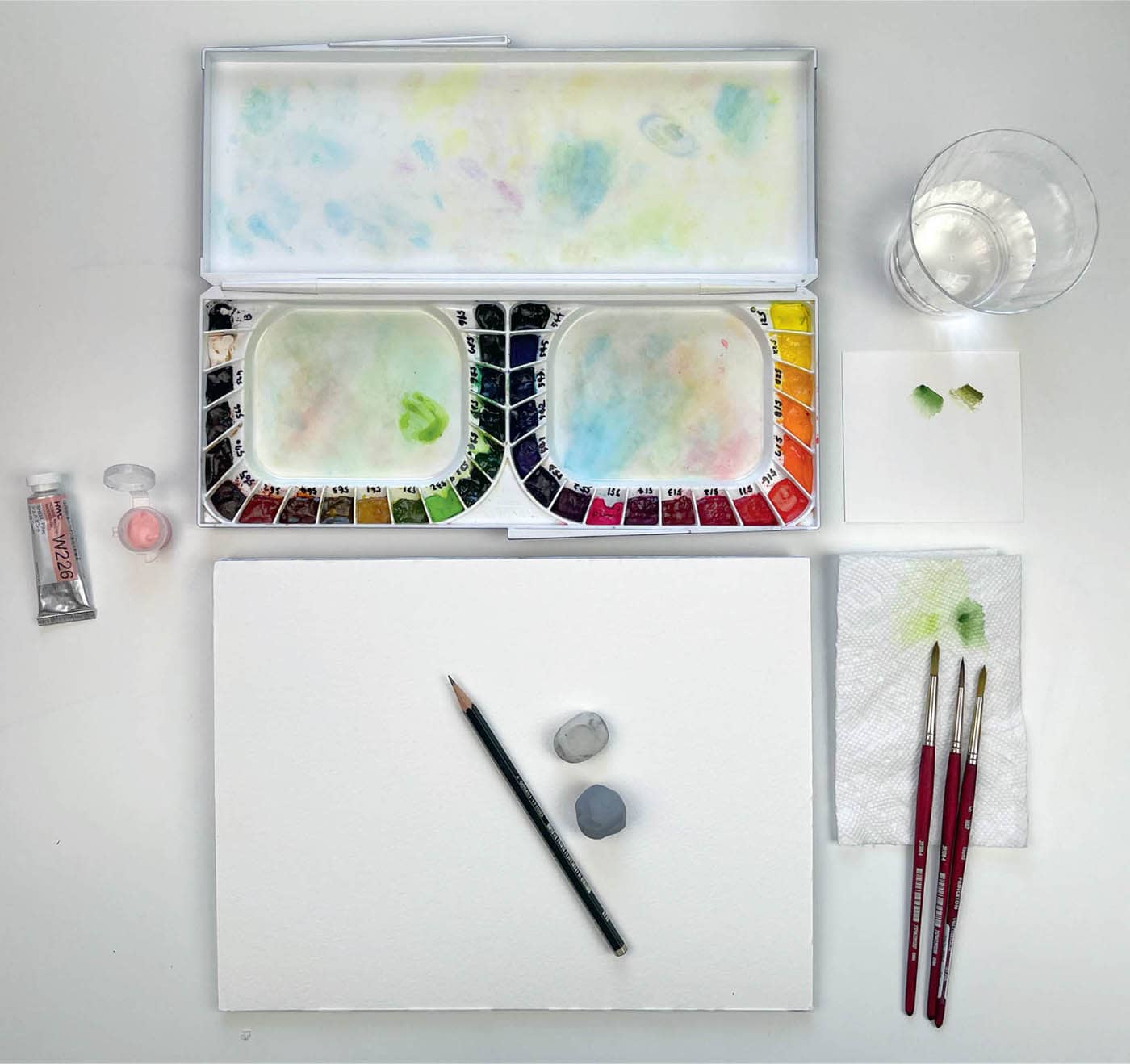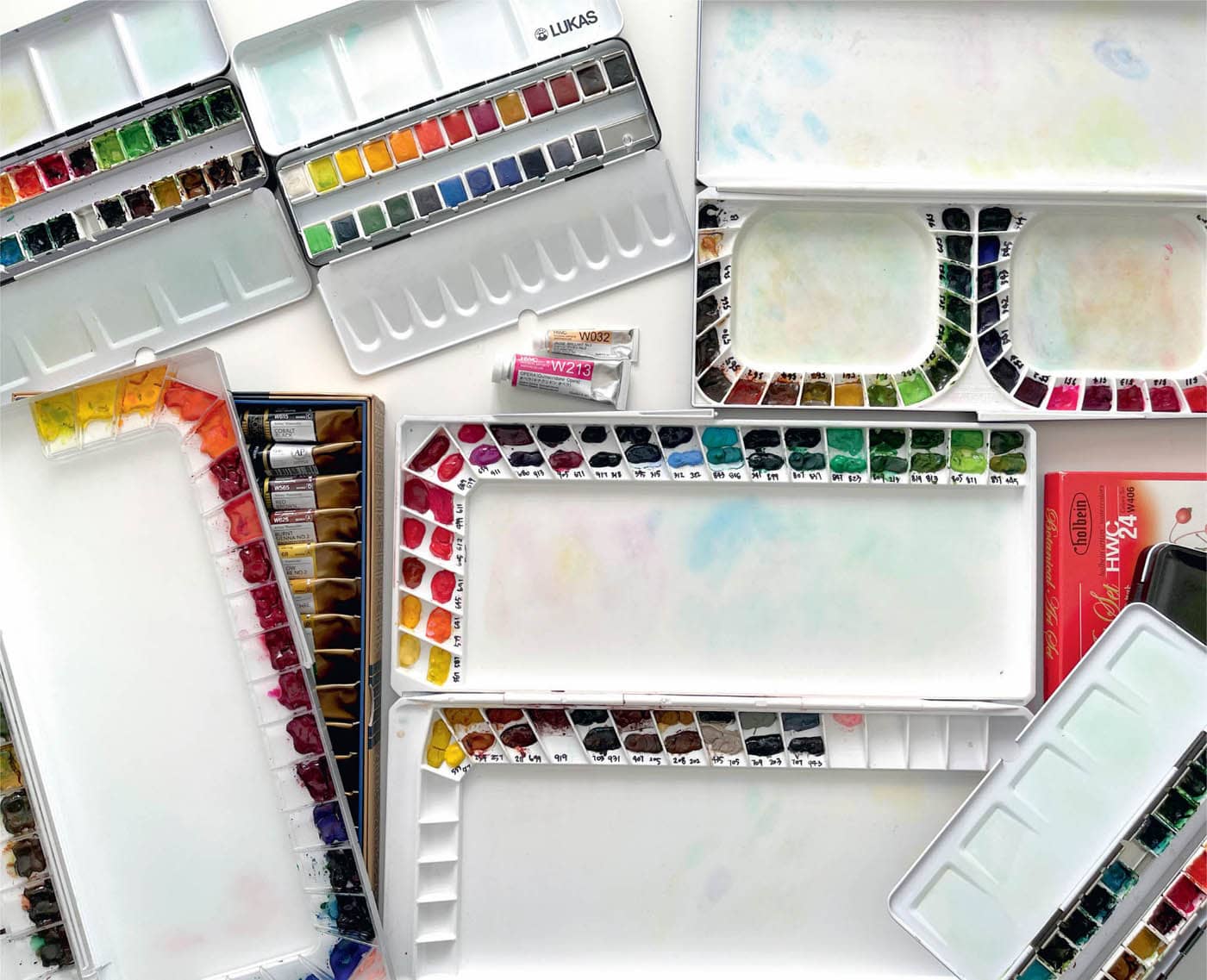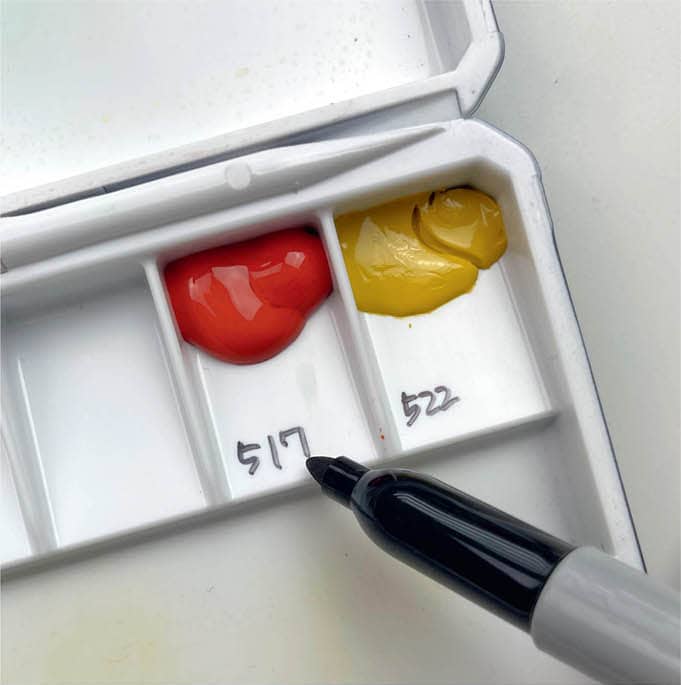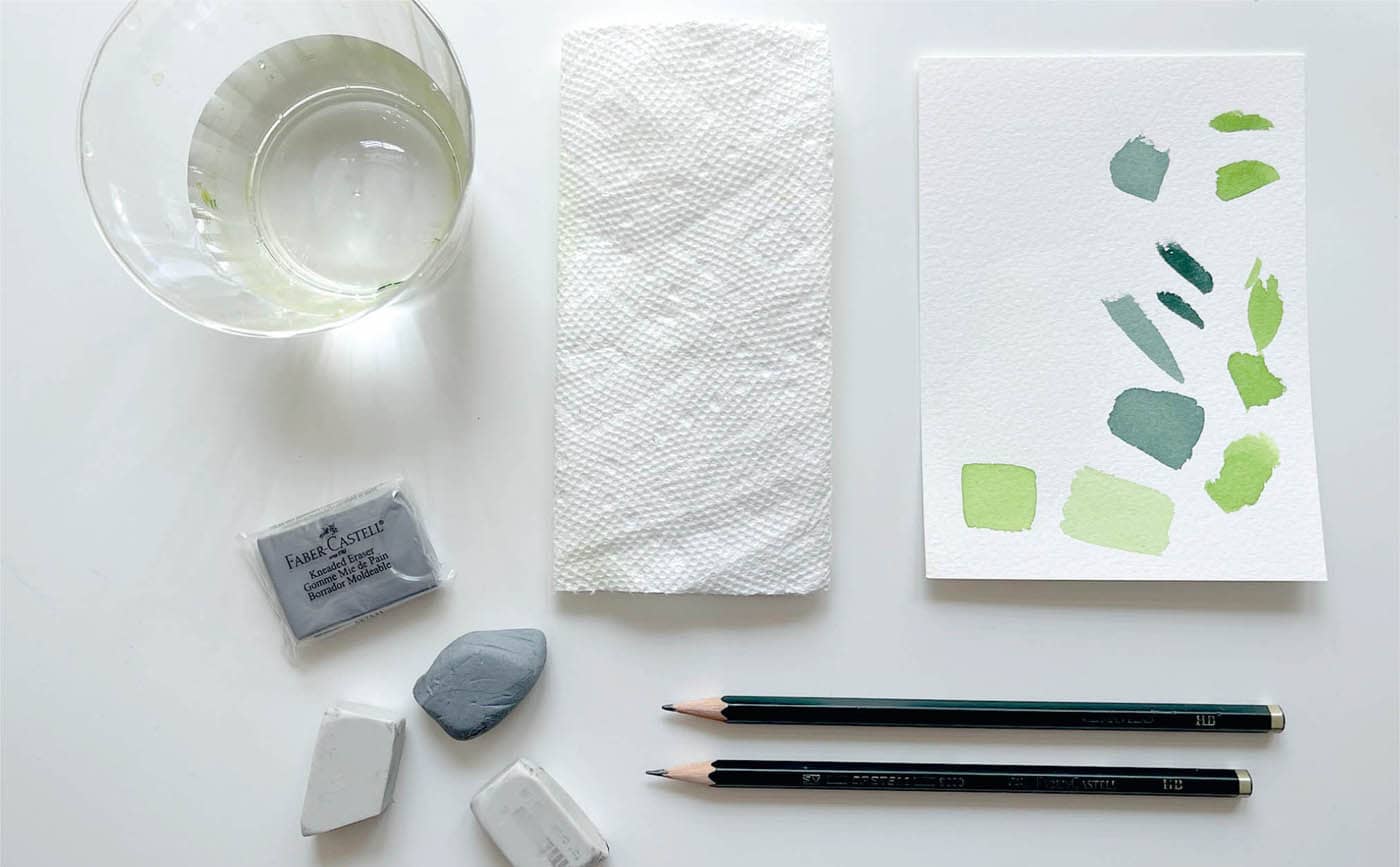Art supply stores are filled with materials, but you only need a few to draw and paint flowers. Basic materials for watercolor painting include watercolors, a palette, paper, a brush, water, paper towels, scrap watercolor paper for testing, and a pencil and an eraser for sketching. Every flower painting in this book was painted using the materials in this photo, which are also my go-to supplies. Let’s take a closer look at these basics, focusing on the tools in the photo. I recommend using reasonably priced professional-grade watercolors for painting flowers, even for beginners. These paints use better-quality pigments compared to student-grade watercolors and offer strong, clear, and vivid colors with longer-lasting lightfastness and higher transparency. However, it doesn’t mean all student-grade watercolors are bad. If you’re not ready to make such an investment, purchase the best watercolor set you can afford and upgrade when you can. Two primary forms of watercolors are available on the market: pan and tube paints. The former comes as a hardened paint cake in a small, individual pan. This ready-to-use paint doesn’t need to be squeezed from a tube, and you can easily change the setup and layout of your palette by moving pans around and exchanging colors. Tube watercolor paints are liquid and can be squeezed directly onto a palette. These offer vibrant colors, and you can blend shades without the contamination you can get by dipping the same brush into multiple pans. Some artists like to squeeze tube paints into palette wells or individual pans and allow them to harden, making them more portable. Tube paints also allow you to create several different palettes with just one set of paints. For example, I used a set of paints to create two palettes: a large one I use at home, and a small one for traveling. The leftover colors in the tubes can be stored without being contaminated. When you begin to paint, you may find you need colors that aren’t in your paint set, or you may prefer colors from other manufacturers. In most cases, you should achieve good results and have no problem mixing paints from different manufacturers. For example, some paintings in this book used Holbein’s Shell Pink. I often use this color by itself to create pink petals, eliminating the need to mix colors every time. Purchasing one or two frequently used pastel-toned paints separately is a good investment, especially for beginners, because they offer consistent colors and increased transparency. Pastel tones can be a little tricky for beginners to mix because blending certain colors and adding white can affect the paint’s transparency. To add tube watercolors to a palette, place the top of the tube in a well, as shown. Squeeze out the paint starting in the far end of the well and continue until it is filled. Leave the palette out to dry and, after a week or two, the watercolor will harden. Make sure it’s completely dry. Otherwise, you’ll use more watercolor than you need when painting. If you purchase a set of watercolors, you can arrange the colors in the palette as shown on the package, or you can make your own arrangement. I keep the order as is. Watercolor paints have names as well as numbers because it’s sometimes difficult to identify a color by eye when it’s in the package. By marking the paint’s number on the palette well and on a color swatch, you can easily refill or find the color you need—just use the color chip. Paint palettes are typically made from steel, plastic, or ceramic. The size of the palette varies depending on the number of wells that hold paint. The palette in the picture is made of plastic and has 36 wells. Sometimes, palettes are included when you buy watercolors such as the Mijello Mission Gold 36-color set; the palette pictured was included with the paints. When choosing a paintbrush, remember that the smaller the number, the smaller the bristles, and the larger the number, the larger the bristles. For the techniques and lessons in the book, I used Princeton Velvetouch Series 3950 round brushes in sizes 4, 5, and 6. (For some of the paintbrush techniques, larger round brushes will be used.) These are synthetic brushes that have pointed tips, which is characteristic of round brushes. They allow you to paint thick and thin lines, create details, and produce a variety of brushstrokes. These brushes are reasonably priced and the bristles have good elasticity, meaning they return to their original form when wet, making them suitable for beginners. I don’t recommend using brushes that shed or lose bristles. When choosing brushes, purchase the best quality you can afford; better-quality brushes offer better results, and you’ll feel less frustrated, especially when starting out. The Resources section on this page has more information on brushes, and you can also ask for help from knowledgeable salespeople at an art supply store. Watercolor paper comes in three types, each with a different texture: hot press, cold press, and rough. Paper pad covers include all the information about the paper, such as the weight, texture, and contents. For the techniques and projects in this book, I used Fabriano Artistico Extra White 100% Cotton Cold Pressed 300g paper, which is made specifically for watercolor. The name may be long and complex, but it’s favored by watercolor artists and should be easy to find. The higher the cotton content in paper, the more evenly the water is absorbed, which allows paint to spread smoothly without creating stains. For sketching in pencil, paper size and texture aren’t that critical, so use whatever paper you prefer. I use a 9" × 12" (23 × 31 cm) Canson Universal Sketch pad with a spiral binding.THE BASICS
WATERCOLORS
Tube and Pan Watercolors
Adding Tube Watercolors to a Palette

PALETTES
BRUSHES
WATERCOLOR PAPER
SKETCHING PAPER
OTHER MATERIALS
PENCILS
Pencils are used for sketching and drawing, but they’re the easiest supplies to find. Different types of pencils can be used to achieve different effects, but for the sketches in this book I used an HB pencil, which can be found at any art or craft supply store and online. The “H” stands for hard and the “B” stands for black. H pencils are harder and make lighter lines, and B pencils are softer and make darker lines Both are graded by number, from 2H (darkest) to 9H (lightest) and from 2B (lightest) to 9B (darkest). HB is considered a medium-hard pencil and works well for sketching outlines before coloring.
ERASER
Putty or kneaded erasers may be unfamiliar to some, but they’re recommended for drawing since these erasers don’t produce eraser shreds or crumbs. To remove a mark, simply press the eraser onto the paper and lift. These erasers also absorb charcoal pencil marks by lightly pressing and lifting.
Soft erasers (used for art) can lighten pencil lines by pressing them onto marks, or by tapping them lightly on the paper. Either type of eraser can be used for drawing.
WATER JAR
I recommend a moderately sized water jar. Make sure it’s not too deep or wide for your brushes. Never leave your brushes in a water jar for extended periods of time because this can damage both the bristles and the handle.
PAPER TOWELS
Have paper towels or a small cloth towel or rag on hand for wiping water off your brushes after washing. This helps control the amount of water the brush holds.
WATERCOLOR PAPER SCRAPS
Use scraps of watercolor paper to test paint shades, the water-to-paint ratio, and the amount of water in the brush before painting.
MASKING FLUID
Masking fluid creates a barrier on the paper so no paint or water can be absorbed. You can use masking fluid to create white flower petals. When the masking fluid is removed, the petals will remain white, or whatever color the background is. You can also use masking fluid to create small details such as flower stamens or to make large patterns.













